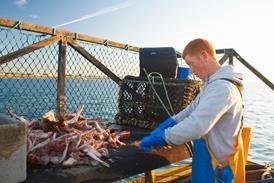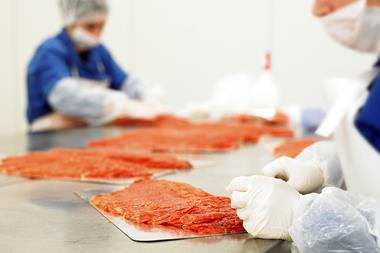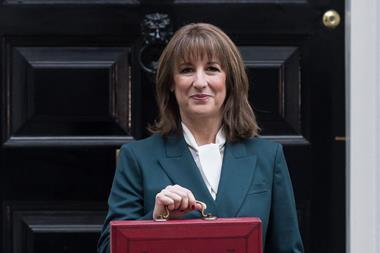Out-of-stocks are dirty words to Brian Gaunt, Salvesen’s UK MD. Elaine Watson hears why
Tackling out-of-stocks is like dealing with a drink problem, says Brian Gaunt. “First you have to stand up and say ‘I am an alcoholic’. Then you can start to deal with it.” Unfortunately, he claims, most retailers are still in denial.
A year into his role as UK MD of Christian Salvesen, Gaunt has decided to grasp this particular industry nettle and start a “frank discussion” about his favourite subject: on-shelf availability.
Despite all the high-tech tools to improve forecasting accuracy and increase the flow of information between trading partners, availability has still not improved, says Gaunt,a former supply chain director at Asda and Big Food Group.
“Better forecasting is crucial, but it won’t solve the problem because poor backroom discipline and stock balance maintenance are still the primary cause of out of stocks.” Warehouse staff usually deal with full cases or pallets at a single temperature, he points out. A computer system co-ordinates goods in and out and staff know exactly where products are. By contrast, staff working in the back of a large superstore handle returned goods, promotional stock that’s come back off the sales floor, goods not for resale, frozen, ambient and chilled food, clothing, with even a few TVs thrown in for good measure. There are single items, cases, rollcages and pallets and goods out in the backyard as well as the backroom.
“To add insult to injury, staff are paid two-thirds what they would make in a RDC driving a forklift,” says Gaunt. And the problem is further compounded by inaccurate stock files, which in turn generate inaccurate store orders. “Every time the wrong item is picked from a distribution centre - and I’d say mis-picking usually runs at about 1% - it creates two stock imbalances in store. You’ve got one item that you didn’t order and you’re still missing the one that you did.”
Likewise, when a barcode doesn’t scan, a ‘dump code’ is often generated so that the item can go through the till, but the stock balance is not updated.
The failure to properly adjust
systems when stock is moved between stores or from shelves to instore restaurants also corrupts the stock file, he adds.
“The problem is that availability is self-monitored by stores and, if performance is tied to pay, there is little incentive for people to give an accurate picture of what is going on.”
On-shelf availability is rarely more than 95% and frequently below 90%, says Gaunt, but an estimated 3% improvement in availability equates to a 1% improvement in sales. “If you are turning over £33bn, that’s a lot of business,” he says.
According to Gaunt, the solution is clear. Either take ownership of the problem, incentivise your staff and run your backroom with the same military precision as a warehouse, or outsource it to a third party logistics operator.
“In the past, retailers have been very much, ‘the backroom is our parish’. I hope that will change. We’re seeing Exel going into B& Q backrooms at the moment on a trial basis, for example, so it will be interesting to see how they get on.”
Details are still under wraps, but he is “putting together a proposition that we can talk about with retailers to finally get to grips with this issue”.
The rest of his time will be spent developing a strategy to get Salvesen back on track after a disappointing year, with group pre-tax profit before exceptionals and goodwill amortisation down 14.9%, primarily because of a disappointing UK performance.
The recent departure of chief executive Edward Roderick has created some uncertainty about Salvesen’s strategic direction, although Gaunt points out the industry in general has seen an enormous amount of upheaval over the last 12 months with rival Exel buying Tibbett & Britten, Frigoscandia/Celsius First being sold to its management and Hays’ logistics arm bought by a private equity firm.
Nevertheless, Gaunt remains resolutely upbeat about opportunities to win new business, not least from a possible re-allocation of contracts following the Exel and T&B tie-up.
He is also keen to get back into chilled foods as well as make real inroads into foodservice and broaden the focus of Salvesen’s industrial division beyond automotives.
Before Gaunt’s arrival, the company had basically stopped chasing certain open book contracts because margins were considered too low - something that they can no longer afford to do, he says. “I want to go in there and get business back.”
A shipping company originally set up in Edinburgh in the 1840s by Norwegian brothers Christian and Theodore Salvesen, Christian Salvesen went on to become the biggest player in whaling by the late 19th century before diversifying into house building, oil, frozen food transportation and industrial logistics in the 20th.
From harpoons to legumes
>>The changing face of christian salvesen
Tackling out-of-stocks is like dealing with a drink problem, says Brian Gaunt. “First you have to stand up and say ‘I am an alcoholic’. Then you can start to deal with it.” Unfortunately, he claims, most retailers are still in denial.
A year into his role as UK MD of Christian Salvesen, Gaunt has decided to grasp this particular industry nettle and start a “frank discussion” about his favourite subject: on-shelf availability.
Despite all the high-tech tools to improve forecasting accuracy and increase the flow of information between trading partners, availability has still not improved, says Gaunt,a former supply chain director at Asda and Big Food Group.
“Better forecasting is crucial, but it won’t solve the problem because poor backroom discipline and stock balance maintenance are still the primary cause of out of stocks.” Warehouse staff usually deal with full cases or pallets at a single temperature, he points out. A computer system co-ordinates goods in and out and staff know exactly where products are. By contrast, staff working in the back of a large superstore handle returned goods, promotional stock that’s come back off the sales floor, goods not for resale, frozen, ambient and chilled food, clothing, with even a few TVs thrown in for good measure. There are single items, cases, rollcages and pallets and goods out in the backyard as well as the backroom.
“To add insult to injury, staff are paid two-thirds what they would make in a RDC driving a forklift,” says Gaunt. And the problem is further compounded by inaccurate stock files, which in turn generate inaccurate store orders. “Every time the wrong item is picked from a distribution centre - and I’d say mis-picking usually runs at about 1% - it creates two stock imbalances in store. You’ve got one item that you didn’t order and you’re still missing the one that you did.”
Likewise, when a barcode doesn’t scan, a ‘dump code’ is often generated so that the item can go through the till, but the stock balance is not updated.
The failure to properly adjust
systems when stock is moved between stores or from shelves to instore restaurants also corrupts the stock file, he adds.
“The problem is that availability is self-monitored by stores and, if performance is tied to pay, there is little incentive for people to give an accurate picture of what is going on.”
On-shelf availability is rarely more than 95% and frequently below 90%, says Gaunt, but an estimated 3% improvement in availability equates to a 1% improvement in sales. “If you are turning over £33bn, that’s a lot of business,” he says.
According to Gaunt, the solution is clear. Either take ownership of the problem, incentivise your staff and run your backroom with the same military precision as a warehouse, or outsource it to a third party logistics operator.
“In the past, retailers have been very much, ‘the backroom is our parish’. I hope that will change. We’re seeing Exel going into B& Q backrooms at the moment on a trial basis, for example, so it will be interesting to see how they get on.”
Details are still under wraps, but he is “putting together a proposition that we can talk about with retailers to finally get to grips with this issue”.
The rest of his time will be spent developing a strategy to get Salvesen back on track after a disappointing year, with group pre-tax profit before exceptionals and goodwill amortisation down 14.9%, primarily because of a disappointing UK performance.
The recent departure of chief executive Edward Roderick has created some uncertainty about Salvesen’s strategic direction, although Gaunt points out the industry in general has seen an enormous amount of upheaval over the last 12 months with rival Exel buying Tibbett & Britten, Frigoscandia/Celsius First being sold to its management and Hays’ logistics arm bought by a private equity firm.
Nevertheless, Gaunt remains resolutely upbeat about opportunities to win new business, not least from a possible re-allocation of contracts following the Exel and T&B tie-up.
He is also keen to get back into chilled foods as well as make real inroads into foodservice and broaden the focus of Salvesen’s industrial division beyond automotives.
Before Gaunt’s arrival, the company had basically stopped chasing certain open book contracts because margins were considered too low - something that they can no longer afford to do, he says. “I want to go in there and get business back.”
A shipping company originally set up in Edinburgh in the 1840s by Norwegian brothers Christian and Theodore Salvesen, Christian Salvesen went on to become the biggest player in whaling by the late 19th century before diversifying into house building, oil, frozen food transportation and industrial logistics in the 20th.
From harpoons to legumes

















No comments yet